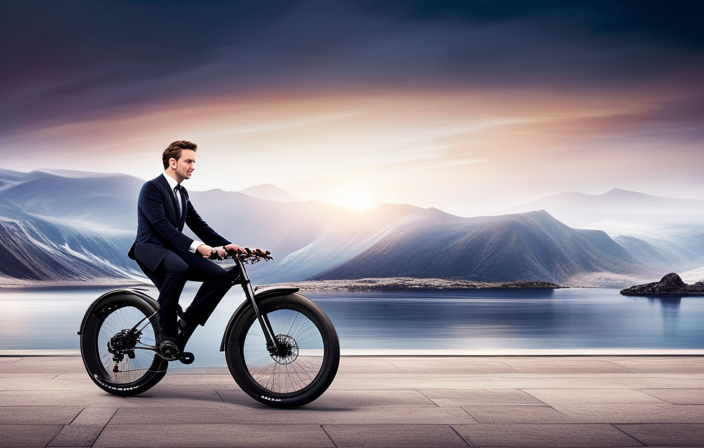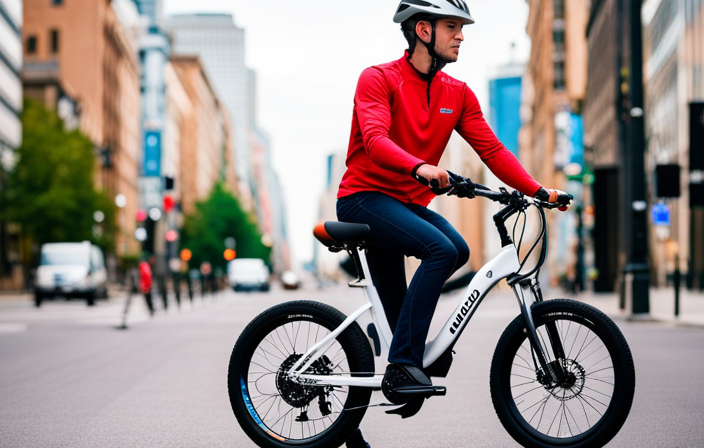Ever dreamed of having an electric bike without breaking the bank? Well, look no further! In this guide, I’ll show you step-by-step how to transform your current bike into an eco-friendly electric ride for under $500.
From assessing your bike to installing the conversion kit and connecting the motor controller, I’ll provide all the technical details and information you need.
Get ready to embark on an electrifying journey and enjoy the thrill of riding your very own budget-friendly electric bike!
Key Takeaways
- Electric bike assembly and installation can be done with steps such as electrical system connection, rear wheel installation and chain adjustment, and pedal assist sensor installation.
- Accessories like lights, locks, racks, bells, and mirrors can enhance safety and functionality of the electric bike.
- Regular maintenance and upkeep, including cleaning, checking tire pressure, lubricating the chain, troubleshooting common issues, and following the manufacturer’s manual, are important for keeping the electric bike in good condition.
- When using an electric bike, it is crucial to follow local laws and regulations, such as adhering to speed limits, wearing appropriate safety gear, respecting pedestrian and traffic laws, obeying traffic signals, and using designated bike lanes.
Assess Your Current Bike
First, take a look at your current bike to see if it can be converted into an electric bike. Assessing the bike condition is crucial in determining compatibility for the conversion.
Start by inspecting the frame for any cracks or damages that could affect the overall stability and safety of the electric bike. Check the wheels, brakes, and gears to ensure they are in good working condition.
Next, examine the drivetrain and determine if it can handle the additional weight and power of an electric motor. Look for any signs of wear and tear on the chain, cassette, and derailleur.
Lastly, assess the available space on the frame for accommodating the battery and other components. With a thorough assessment, you can now transition into the next section about researching and purchasing the right conversion kit.
Research and Purchase the Right Conversion Kit
To begin, you’ll want to research and purchase the right conversion kit for your budget. Researching conversion kits is crucial in ensuring that you make an informed decision. Start by comparing conversion kit options available in the market. Look for kits that are compatible with your bike’s specifications, such as wheel size and frame type. Consider factors like motor power, battery capacity, and range.
Read reviews and user experiences to get a sense of the kit’s performance and reliability. It’s also important to compare prices and warranties offered by different manufacturers. Once you have gathered all the necessary information, you can make a well-informed decision and purchase the conversion kit that best suits your needs.
With the right kit in hand, you can now move on to gathering the necessary tools and equipment for the conversion process.
Gather the Necessary Tools and Equipment
Once you’ve researched and purchased the right conversion kit, it’s time to gather the necessary tools and equipment for the job. Here are three essential items you’ll need:
-
Wrench set: A good set of wrenches will be crucial for removing and installing various components on your bike. Make sure you have both metric and standard sizes to accommodate different bolt sizes.
-
Tire levers: You’ll need tire levers to remove the rear wheel from your bike. These small, curved tools help you pry the tire away from the rim, making it easier to access the wheel and install the electric motor.
-
Allen key set: Many bike components, such as the handlebars and seat post, are secured with Allen bolts. Having a set of Allen keys in various sizes will allow you to loosen and tighten these bolts as needed during the conversion process.
Now that you have all the necessary tools and equipment, it’s time to move on to the next section: removing the rear wheel and installing the electric motor.
Remove the Rear Wheel and Install the Electric Motor
Now that you’ve gathered all the necessary tools and equipment, it’s time to remove the rear wheel and install the electric motor.
Start by turning off the bike and placing it in a stable position. Use a wrench to loosen and remove the nuts or quick-release skewer that hold the rear wheel in place.
Carefully slide the wheel out, being mindful of any attached components like the derailleur or chain.
Once the wheel is removed, locate the electric motor and position it onto the bike frame. Secure it tightly using the provided brackets and screws.
After installing the motor, the next step is to connect the motor controller and battery. This will allow the motor to receive power and control the bike’s speed.
Transitioning into the subsequent section about connecting the motor controller and battery, it is crucial to ensure proper wiring and connections to ensure the safe and efficient operation of your electric bike.
Connect the Motor Controller and Battery
After securing the electric motor onto the bike frame, it’s important to connect the motor controller and battery for proper operation. Here are the steps to follow:
- Ensure that the wiring connections between the motor controller and the motor are secure and properly insulated.
- Check the compatibility of the motor controller with your electric motor. Refer to the manufacturer’s specifications and documentation.
- Connect the battery to the motor controller using the appropriate wiring harness or connectors.
- Double-check all the connections to ensure they are tight and secure.
- Test the motor controller and battery connection by turning on the power and observing any error codes or indicators.
Once the motor controller and battery are properly connected, you can proceed to the next step of the process, which is to mount the battery and secure the wiring.
Mount the Battery and Secure the Wiring
To mount the battery and secure the wiring, follow these steps:
- Select a suitable location on the frame to secure the battery. Make sure it is easily accessible and won’t interfere with other components.
- Use the provided mounting brackets or straps to secure the battery firmly in place. Ensure it is tightly fastened to prevent any movement during rides.
Next, manage the wiring:
- Neatly route the wiring along the frame.
- Secure the wiring with zip ties or clips to prevent any loose wires that could potentially get tangled or damaged.
- Leave enough slack in the wiring for easy connection and disconnection.
With the battery mounted and the wiring secured, you are now ready to move on to the next step and install the throttle and brake levers.
Install the Throttle and Brake Levers
For installing the throttle and brake levers, you’ll need to position them on the handlebars in a comfortable and accessible location.
The throttle installation tips are as follows:
- First, locate the appropriate spot on the handlebars and ensure that it is clear of any obstructions.
- Then, secure the throttle in place using the provided clamp or mounting bracket.
- Make sure it is firmly attached but can still rotate smoothly.
- Next, connect the throttle wires to the corresponding connectors on the electrical system.
Now, let’s move on to the brake lever adjustment tricks.
- Ensure that the brake levers are positioned within easy reach of your fingers, allowing for quick and efficient braking.
- Adjust the lever reach and angle to your preference, ensuring a comfortable grip.
With the throttle and brake levers installed, we can now proceed to connect and test the electrical system.
Connect and Test the Electrical System
Once the throttle and brake levers are securely installed, it’s time to connect and test the electrical system. This step is crucial to ensure that your electric bike functions properly.
Start by connecting the motor controller to the battery and the throttle. Double-check all the connections to make sure they are secure and properly insulated.
Once everything is connected, it’s time to test the performance of your electric bike. Take it for a short ride and observe how it accelerates and brakes. If you notice any issues, such as a lack of power or inconsistent performance, it’s important to troubleshoot common electrical issues.
This may involve checking the wiring, inspecting the connections, and ensuring that all components are functioning correctly. Once you are satisfied with the performance and have resolved any issues, you can move on to the next step, which is to reinstall the rear wheel and adjust the chain tension.
Reinstall the Rear Wheel and Adjust the Chain Tension
After successfully connecting and testing the electrical system, it’s time to move on to the next step: reinstalling the rear wheel and adjusting the chain tension.
This crucial step ensures that the chain is properly aligned and tensioned, optimizing the bike’s performance and preventing any potential issues.
To begin, I carefully lift the rear wheel and align it with the dropouts on the frame. Once aligned, I slide the axle through the dropouts and secure it with the nuts or quick-release skewer.
Next, I adjust the chain tension by loosening the axle nuts and sliding the wheel back or forth until the chain has the correct tension.
Finally, I tighten the axle nuts to secure the wheel in place.
With the rear wheel properly installed and the chain tension adjusted, I can now move on to the next section: installing the pedal assist sensor (optional).
Install the Pedal Assist Sensor (Optional)
To install the pedal assist sensor, you’ll need to locate the designated spot on the frame and carefully attach it using the provided screws.
The pedal assist sensor is an optional component that can greatly enhance your electric bike riding experience. It works by detecting the motion of your pedals and providing additional power from the motor to help you pedal with less effort.
The benefits of pedal assist include extended riding range, reduced fatigue, and the ability to tackle hills and challenging terrains more easily.
When installing the sensor, make sure to align it properly with the crank arm and secure it tightly to prevent any movement.
Once the pedal assist sensor is installed, you can move on to the next step of the process: test ride and fine-tune the electric bike.
Test Ride and Fine-Tune the Electric Bike
Now, take the electric bike for a test ride and adjust any necessary settings to fine-tune your riding experience.
Start by choosing the right battery for your electric bike. Consider factors such as capacity, voltage, and weight to ensure optimal performance.
Once you have installed the battery, it’s time to adjust the motor power. This will determine the level of assistance provided by the electric motor. Find a suitable setting that suits your riding style and preferences.
Take the bike for a spin, paying attention to how the motor power affects your speed and effort. Make any necessary adjustments to achieve the desired balance.
Once you have fine-tuned the performance, consider adding accessories for safety and convenience, such as lights, locks, and racks.
Consider Adding Accessories for Safety and Convenience
Consider adding accessories like lights, locks, and racks to your electric bike for added safety and convenience. These accessories not only enhance your riding experience but also significantly improve your safety on the road. Lights are essential for increasing your visibility, especially when riding at night or in low-light conditions. Bells and mirrors provide an additional layer of safety by alerting pedestrians and other cyclists of your presence. Furthermore, considering adding a basket or panniers to your electric bike can greatly enhance its convenience, allowing you to carry your belongings or groceries effortlessly. Below is a table summarizing the various accessories you should consider for your electric bike:
| Accessory | Purpose |
|---|---|
| Lights | Increase visibility |
| Locks | Secure your bike |
| Racks | Carry additional items |
| Bells | Alert pedestrians and cyclists |
| Mirrors | Monitor traffic behind you |
Regular Maintenance and Upkeep
For optimal performance, it’s important to regularly maintain and upkeep your electric bike. There are several types of regular maintenance that you should perform to ensure that your bike is in top shape.
Firstly, you should regularly clean your bike to remove any dirt or debris that may have accumulated. This helps prevent damage to the components and keeps everything running smoothly.
Additionally, you should check the tire pressure regularly and inflate them as needed. This will ensure a comfortable and safe ride.
Another important maintenance task is to lubricate the chain and other moving parts to reduce friction and extend their lifespan.
Common issues that you may encounter include battery problems, motor malfunctions, and electrical issues. If you experience any of these, try troubleshooting by checking the connections, charging the battery, or consulting the manufacturer’s manual.
By following these maintenance tips and troubleshooting common issues, you can keep your electric bike in excellent condition.
Now, let’s move on to the next section about following local laws and regulations.
Follow Local Laws and Regulations
It’s essential to follow local laws and regulations when using your e-bike. Electric bike laws and safety precautions vary from place to place, so it’s important to be aware of the rules in your specific location. Here are three key things to keep in mind:
-
Know the speed limits: Different areas may have different speed limits for electric bikes. Make sure you understand and adhere to these limits to ensure your safety and comply with the law.
-
Wear appropriate safety gear: Just like with any other bicycle, it’s crucial to wear a helmet when riding your e-bike. Additionally, consider wearing reflective clothing and using lights to increase your visibility, especially when riding at night.
-
Respect pedestrian and traffic laws: Treat your e-bike like any other vehicle on the road. Obey traffic signals, yield to pedestrians, and use designated bike lanes whenever possible.
Enjoy Your Eco-Friendly and Budget-Friendly Electric Bike!
Now that we have covered the importance of following local laws and regulations when building your electric bike, it’s time to focus on the benefits of owning an eco-friendly and budget-friendly electric bike. With the increasing concern for the environment, eco-friendly transportation options have become more popular than ever. Electric bikes offer a sustainable and efficient mode of transportation, emitting zero emissions and reducing your carbon footprint. Moreover, electric bikes are becoming more affordable, making them accessible to a wider range of individuals. The advancements in technology have led to the development of affordable electric vehicles that provide excellent performance and range. These budget-friendly options allow individuals to enjoy the convenience and cost-saving benefits of electric transportation without breaking the bank.
| Benefits of Eco-Friendly and Budget-Friendly Electric Bikes | ||
|---|---|---|
| 1. Sustainable mode of transportation | 2. Zero emissions and reduced carbon footprint | 3. Accessibility to a wider range of individuals |
| 4. Advancements in technology | 5. Affordable options with excellent performance and range |
Frequently Asked Questions
Can I convert any type of bicycle into an electric bike?
Yes, not all bicycles are compatible with electric bike conversion kits. However, many types, including mountain, road, and hybrid bikes, can be converted. The benefits of converting a bike include increased speed and range, and a more eco-friendly mode of transportation.
What are the advantages and disadvantages of using a conversion kit instead of buying a pre-made electric bike?
Using a conversion kit has its perks and pitfalls. Advantages include customization and cost-effectiveness, while disadvantages involve technical know-how and potential compatibility issues. It’s a double-edged sword, offering freedom and challenges.
How long does it typically take to convert a regular bike into an electric bike?
Typically, converting a regular bike into an electric bike can take anywhere from a few hours to a few days, depending on the complexity of the conversion and the skill level of the person performing it. It is important to choose the right conversion kit options and follow best practices for electric bike conversion to ensure a successful and efficient process.
Are there any additional costs or fees associated with owning an electric bike?
Yes, there are additional costs and maintenance fees associated with owning an electric bike. These can include battery replacements, regular servicing, and potential repairs. It’s important to budget for these expenses when considering purchasing an electric bike.
Are there any safety concerns or precautions I should be aware of when riding an electric bike?
When riding an electric bike, it is important to prioritize safety. Wearing appropriate safety gear, such as a helmet and reflective clothing, is crucial. Additionally, always be cautious when riding in traffic and follow all traffic laws and regulations.
Conclusion
In conclusion, I’ve successfully created an electric bike under 500 using a conversion kit and basic tools.
It was a challenging but rewarding process, and I’m thrilled with the results.
Now, I can enjoy the freedom of riding a budget-friendly and environmentally-friendly electric bike.
It’s like a dream come true, a breath of fresh air in a world full of congestion and pollution.
So why wait?
Get your hands dirty and embark on this electrifying journey yourself!








